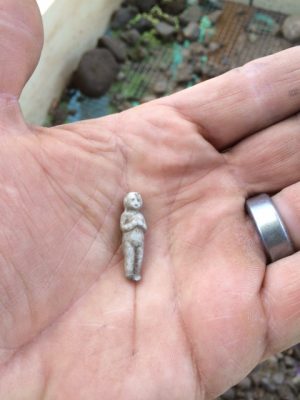Frozen Charlotte

A mid-19th century "frozen Charlotte" penny doll from the David Humphreys House, Ansonia.
UConn Office of Public Engagement Newsletter Fall 2016
During the summer months of 2016, members of the public worked with the Office of State Archaeology at two historically significant sites: the Captain John Mason house site in Windsor, and the Lieutenant John Hollister farm in Glastonbury. A special one week field school program specifically for secondary school teachers was piloted this year at the John Mason house site. The program was developed to provide educators with a hands-on experience in archaeology so that they could share their enthusiasm for the past with their students in the classroom. Work at the site focused on the examination of a filled 1635 house cellar believed to be that of Captain John Mason. Mason is an historically controversial figure, famous for leading the colonial militia in a bloody war against the Pequot tribe in 1636. The house was afterwards occupied by the Marshall family through the 18th century, and most of the artifacts reflect their use of the property. One of the teachers produced a very engaging video of the excavation to share with his students. Imaginative independent projects such as that one have set a precedent and new standard for future field schools for educators planned for next year.
The Lt. John Hollister Site is a large farming complex dating between 1650 and ca. 1715. The site is unique both for its scale and degree of preservation and is arguably the most significant archaeological site in the state. Archaeological work conducted at the site in Glastonbury included a one week adult field school offered through the Connecticut State Museum of Natural History. Field school participants included college students, seniors, and working professionals, including a city planner. The Office of State Archaeology also supervised one day public excavation programs for the Historical Society of Glastonbury and two local scout troops. Work at the Hollister Site was wrapped up by volunteer members of the Friends of the Office of State Archaeology who helped supervise work at both locations.
While many archaeologists run “sand box” excavations for the public using artificially constructed sites, I believe that permitting the public to conduct authentic hands-on research is the best way to encourage a long-term interest and investment in the past. Ultimately, the goal of these programs is less about the artifacts and data recovered (though these can be very significant) than it is about instilling a preservation ethic in the public. Archaeologists, like other historic preservationists, are challenged daily with the loss of information about our shared past, usually because of the lack of knowledge of those making planning decisions. The hands-on experience provide by public outreach field schools in archaeology helps to bring the past alive in the most tangible of ways, developing a grass roots investment in the past that can have long-term repercussions for historic preservation.